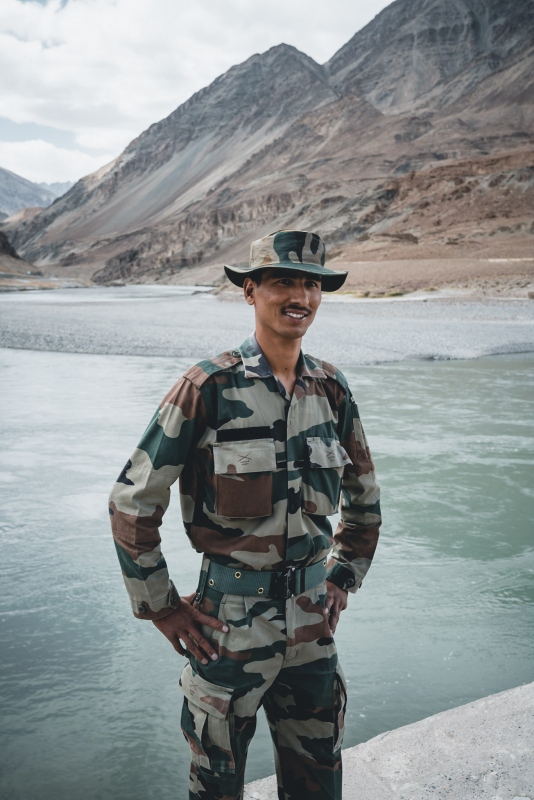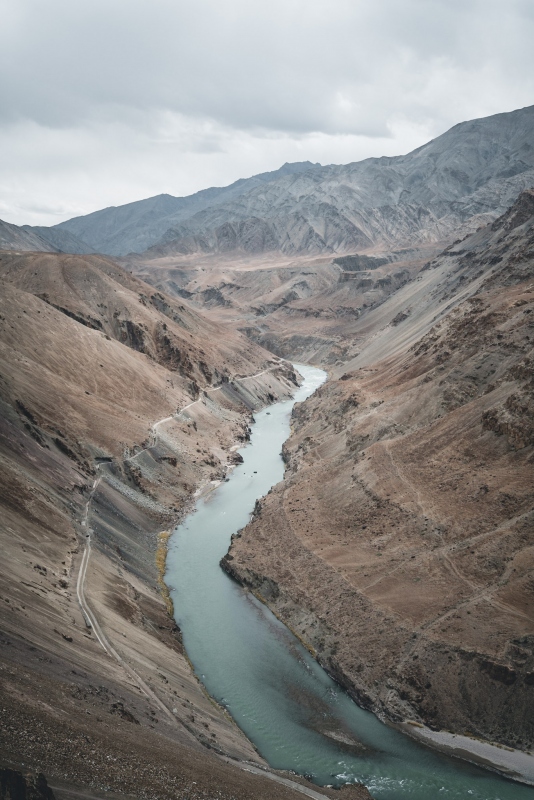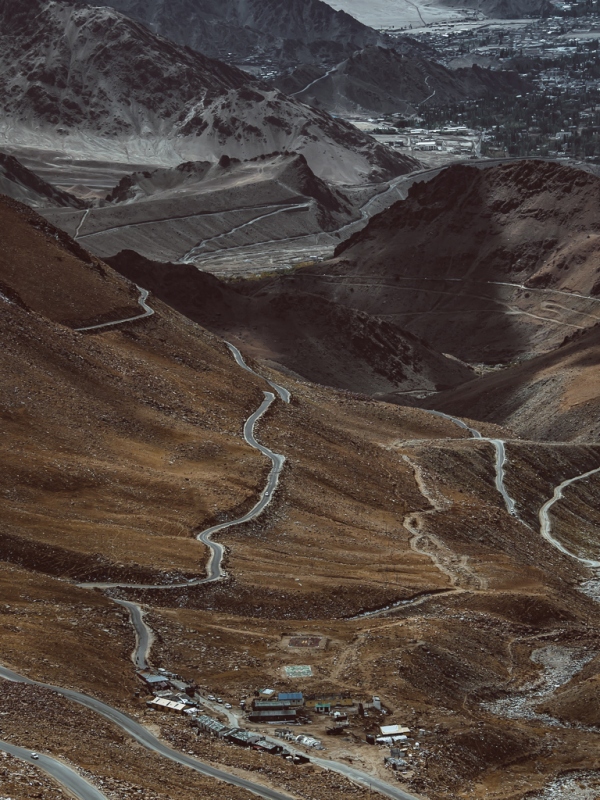Ladakh, in Indian Jammu and Kashmir, is often called as “small Tibet”, because of the common cultural and religious heritage. It is more or less as big as England and the population of the citizens is as big as one of the Hong Kong districts. This mountainous region is situated in the northwest India, between the main ridge of the Greater Himalayas and Karakoram mountains and it is still not a popular travel destination, untouched by mass tourism. It is one of those areas you should invest time to prepare for but it makes it absolutely unique.
The name “la dags”, meaning “the region of mountain passes”, is used not without cause, because almost everything here is above 3000 m above sea level and most of the passes you should go through while travelling here, is even above 5000 m. So this is the area only for the tough people, resistant to hardships of journey and those, who can endure a lot in exchange for experiencing severe beauty of this part of the world.

This most western part of the Tibetan Plateau is poor in vegetation, which you can only see in valleys and irrigated fields. The landscape dissimilarity from most of the Indian Himalayas region is caused by the isolation from humid air masses and summer monsoon rains, as Ladakh is situated to the north of the main ridge of the Greater Himalayas, which act as a climate barrier.
A considerable part of Ladakh consists of Zanskar Range. The southwest border is made of the main ridge of the Greater Himalayas. Snow and glaciers, covering the mountain peaks, melt slowly in spring and summer, creating creeks and rivulets. In the southern part of Ladakh they join to form Zanskar River. It is one of the main tributary of the Indus River in the region and forms a vast valley. The land around it – formerly a separate kingdom – is called Zanskar and its main city is Padum.
Contrary to the harsh climate of these inhospitable terrains, the citizens are extremely hospitable and are a really cheerful folk. In most of the houses and restaurants you will find an inscription, which could be translated as “What’s ours is yours”, depicting how open and kind they are towards another human being. Most of the Ladakhian inhabitants are descendants of the Tibetans, who travelled to this region more than thousand years ago. They speak a language, which is a part of Tibetic languages, while the most prevalent religion is Tibetan Buddhism. In the face of Chinese dominance in Tibet, Ladakh is one of the best places in the world to get to know the Tibetan culture in peace and among smiles and balanced life, which are its core values.


You come here not only for the views but most of all for the people. They are warm hearted, they never refuse to help someone and they often take real interest in another human. This is one of the most magnetic aspects of travelling to India.
There are not many such places left on Earth
Harsh mountainous landscapes. Deserts, surrounded by snow-capped peaks and all of it interlarded with rainbow-colored prayer flags, which enliven this homogenous scenery. From one direction blows an ice-cold wind, from another mercilessly burns the sun. Not much flora, not much fauna. Sometimes in the valleys you can bump into grazing yaks. Even though people do leave here, you have the impression of everlasting, never-ending wilderness.
Ladakh is a region full of contrasts. Shaved clearly monks emerge from resplendently white monasteries and squint their eyes in the piercing sunlight. These idyllic scenes are broken suddenly, when one of them suddenly grabs his iPhone and starts calling someone. Try not to smirk then! Globalization cannot be stopped even by the snow-capped Himalayan peaks. On one hand there are lots of Buddhist monasteries there and on the other hand, a huge military base, guarding the borders with China and Pakistan. And among all of that there are the tourists, who begin to pour more and more into this region. But they are a special kind, focused on mountains, trekking and adventurous travelling. Even though Ladakh was opened for tourism only in 1974 and some of the most distant valleys are still off-limits, in order to preserve the traditional lifestyle, tourism is flourishing and yields notable economic benefits. In 2018 the city of Leh was visited by 327 366 tourists, 50 000 people more than in the previous year.



Ladakh is a part of the Indian territory but it’s really hard to associate this region with India. You won’t find here the overwhelming street chaos; you won’t be absorbed by vast crowds. Regardless of a few months with higher temperatures, its ranges during the year are quite big. During the off-summer season the temperatures are rather low, influencing the way of life of the inhabitants. It does not proceed on streets as much as in the Indian subcontinent. In order to approach the citizens and observe their life, you can’t only sit on the pavement and watch. You have to be invited to their world, to their homes and for a brief moment become a part of their daily life. It is not impossible, because home stays, so sleeping in homes of regular people, are one of the most popular ways of travelling here. And it is absolutely remarkable, because it allows you to establish bonds and understand better, feel what living in Himalaya means. The West still could learn a lot from the traditional Ladakhian lifestyle when it comes to balanced development, diet, family values and the general happiness. There are not many such places left on Earth.
Himalayan bridgehead in Leh and excursion base
The capital city of the region is Leh, picturesquely situated in a valley at 3500 m above sea level, between the ridges of the Himalayas and Karakoram mountains. The easiest way to travel to this place is flying from New Delhi. However, there is an issue of reaching a very high altitude from zero level really quickly. Such a sudden change is a direct recipe for getting altitude sickness. So you would have to pay a price for saving time. There is an option of journey overland, however it’s not an easy one. The only two roads, leading to the heart of the region, are opened only from July to October, when snow melts enough to make the crossing available. 475 kilometers long travel from Manali, in neighboring Himachal Pradesh, leads travelers among razor-sharp peaks and high passes, including 5359 m high Khardung La pass, along one of the highest paved roads in the world. The crossing takes almost three days but it grants you celestial views and a chance to gradually acclimatize yourself to the changing altitudes.



Travelling should become easier in the next year, thanks to finishing the Rohrang tunnel, a transhimalayan passage, which should significantly shorten the road and provide an all-year-round contact with Ladakh. The long-expected railroad track from Manali to Leh, which should be finished till 2022, should open this virgin region even more.
Except for temples, markets and monasteries, Leh is a city for watching, observing and absorbing. Everything in here is interesting, especially the simple daily presence and activities. Walking the small streets, buying apricots from local market sellers, exchanging endearments and cordialities, drinking a warming cup of tea with yak milk in one of the small cafes at the market. The reality drags you in with tastes, smells, noises and colors.
After a few days of acclimating in the city and the obligatory visit in the Leh Palace or surrounding Buddhist monasteries (called “gompas”), you can set off to meet the real Himalayas. Leh is a perfect excursion base for all sorts of mountain trekkings. You’d have plenty to choose from. Beginning with a few-days-long trips in the lower parts of the nearby mountains, including staying overnight in local villages, to a few-week-long excursions for the most seasoned travelers, which guarantee you experiencing the Himalayas in the most untouched and stunning form – but they require preparation, equipment and a guide.
Travelling through Ladakh - adrenaline, challenges and limitless spaces
Of course, you can also tour Ladakh by car, what gives you possibility to reach its most distant ends and see the wonders of nature. However, nothing would top driving around Ladakh on motorcycle, which – let’s be frank here – gives you unrestricted feeling of freedom and space. You can rent a motorcycle in few places in Leh, because the motorcycle route in the region is considered one of the most beautiful and challenging in the whole world.
In spite of appearances, Ladakh has really a lot of attractions for those who crave for adrenaline and challenges. One of them is rafting – depending on the difficulty level – on Zanskar River or Indus River. A few-hour rafting does not only provide you with emotions on the highest level (literally and figuratively) but it also gives you a chance to admire the landscapes from a totally different perspective.



Even bigger challenge is riding a bike down the Khardung La pass, which not long ago was considered the highest situated pass in the world (but if you ask anyone from Ladakh, they will convince you that it is the highest one and moreover, it’s also the most beautiful one in the world – their national pride is really worthy of admiration). However, the newest measurements proved recently that Khardung La is situated “only” at 5359 m above the sea, so about 200 m lower than the altitude written proudly on the information plaque (but who would argue about only 200 meters).

To reach the most known natural places in the region, you would have to drive for a few hours on winding, narrow roads at high altitudes and often breaching through your own barriers of patience, endurance and acceptance for unplanned events (like getting stuck at more than 5000 m for 2 hours because of the break in the weather and snowstorm). It is best to plan a few-days-long off-road trip, following the wonders of nature, beginning with salt lake Leh Pangong Tso, the highest situated lake in India, which during the season attracts cinema enthusiasts and Instagrammers, who want to see, where the last scene of Bollywood hit 3 Idiots (2009) was shot. It is definitely worth to drive through a spectacular Nubra valley, where yaks graze in summer. One of the attractions is safari on two-humped Bactrian camels on sand dunes around the Hunder village, which in the past was a post of the Silk Road. But not just to ride on them but to admire the majesty of these animals, having the snow-capped Himalayan peaks in the background.




The dark side of Ladakh
In 1928 a British-Hindu soldier and writer Martin Gompertz wrote about Ladakh that this region is self-sufficient and the local people produce everything they need, except for the tea. Inhabitants of Kashmir speak about Ladakh citizens in similar spirit. They even came up with a witty saying (free translation): The Ladakhians eat sattu, wear pattu and ride on tattu, where sattu is barley flour, pattu – woolen clothing and tattu – ponies. These opinions show you the idea of how materially simple was the everyday life of these inhabitants, living in this demanding area.
The inflow of tourists begins to slowly muddy the image of traditional life, subordinate to the whims of the weather. The notable economic benefits of tourism concern only a small group of tour operators, owners of hotels and merchants – many of them come from different places in India and visit Leh only during tourist seasons.
The farmers, so the majority of the whole population, did not see the improvement of their lives but instead were forced to manage the negative social, environmental and psychological effects of changes in the Ladahkian economy, from the one based on self-sufficiency to an economy driven by foreign markets.
Ladakh doesn’t seem to be prepared for progressing changes and challenges, resulting from seasonal and intensive inflow of tourists. It is estimated that in Leh 30 000 plastic water bottles are being disposed of every day. Like everything else, they are being transported thousands of kilometers into the Himalayas. Ladakh doesn’t have a system of sorting and burning waste, however advices and requests to take non-biodegradable trash back to New Delhi, don’t seem to work. All right, compared to subcontinental India or Nepal, the streets are not drowning in rubbish but you can see them everywhere and they appear to grow in numbers. Even in the wilderness, where people do not live, you can see waste littering the shoulders of the roads, thrown away by the passing people.

The exhaust fumes are another problem. They are emitted in vast amounts by the cars, standing in the neutral gear in traffic jams in Khardung La and other bottlenecks at high altitudes. It’s a really shocking view, when against a background of a crystal-clear Himalayan air, you can see a black cloud of smoke and fumes, which makes it almost impossible to breathe. The effects of the global climate change are more and more visible in the environmentally sensitive Himalayas. It’s enough just to talk with the local citizens. The Ladakhians say that they have never seen such rough climate conditions. Lightning-fast floods, caused by short but very heavy rains, are unsettling enough. On the other hand, the smaller snowfall, resulting in droughts, bears much more serious long-term ramifications. It is predicted that the glacier, on which Leh is totally dependent, will melt completely in five or six years. Because of that the hotel owners already began boring out wells, searching for elusive groundwater.
The hasty modernization doesn’t help in that matter too. Substituting the traditional dry toilets with the western system of flushing poses even bigger infrastructural demands, for example to the limited water supplies. As the engineer and educationalist Sonam Wangchuk said: If people from the big cities live simply, then people in the mountains could simply live.
Everything is linked with each other, like a huge butterfly effect. Even the slightest change impacts this place, which still fights and struggles to stay a virgin and untouched – and thanks to this also an absolutely unique one as well.
The photos you can see in this post are the effect of my collaboration with Michael. We believe in the synergy effect, which is why we have decided to work together during this trip. We hope that it will be an inspiration for your own trips.









